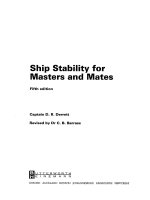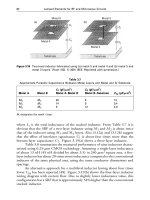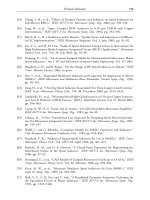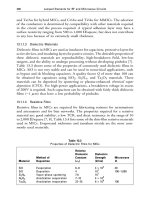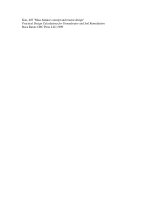Ship Stability for Masters and Mates 5 Episode 9 ppsx
Bạn đang xem bản rút gọn của tài liệu. Xem và tải ngay bản đầy đủ của tài liệu tại đây (632.48 KB, 35 trang )
The moment of the thrust wEgEbEx
2
Esin yEdx
on the strip about AB
The moment of the
a
O
wEgEbEx
2
Esin y
total thrust about AB
wEgEbE
a
3
3
Esin
Let
"
X be the distance of the centre of pressure (P) from AB, then:
"
X Â Total thrust Total moment about AB
"
X Â wEgEbE
a
2
2
Esin y wEgEb
a
3
3
Esin y
or
"
X
2
3
a (unless sin y=0)
(ii) For any Plane Area immersed in a liquid.
In Figure 30.3, let OY be the line in which the plane cuts the surface of
the liquid. Let the plane be inclined at an angle y to the horizontal.
Let h the x co-ordinate of the centroid (G), and
let w the mass density of the liquid.
Depth of the element dA xEsin y
Thrust on dA wEgExEsin yEdA
Moment of thrust about OY wEgEx
2
Esin yEdA
Moment of total thrust about OY
wEgEx
2
Esin yEdA
wEgEsin yE
x
2
EdA
Liquid pressure and thrust. Centres of pressure 269
Fig. 30.3
Total thrust on A wEgEAEDepth of centroid
wEgEAEhEsin y
Moment of total thrust about OY wEgEAEhEsin yE
"
X
; wEgEAEhEsin yE
"
X wEgEsin yE
x
2
EdA
or
"
X
x
2
EdA
hA
(Unless sin y 0)
Let I
OY
be the second moment of the area about OY, then
I
OY
x
2
EdA
and
"
X I
OY
hA
or
"
X
Second moment of area about the waterline
First moment of area about the waterline
Centres of pressure by Simpson's Rules
Using Horizontal Ordinates
Referring to Figure 30.4:
Thrust on the element wEgExEyEdx
Moment of the thrust about OY wEgEx
2
EyEdx
Moment of total thrust about OY
wEgEx
2
EyEdx
wEg
x
2
EyEdx
Total Thrust wEgEAEDepth of centroid
wEgE
yEdxE
xEyEdx
yEdx
wEgE
xEyEdx
Moment of total thrust about OY Total Thrust Â
"
X
270 Ship Stability for Masters and Mates
where
"
X Depth of centre of pressure below the surface
; Moment of total thrust about OY wEgE
xEyEdx Â
"
X
or
wEgE
xEyEdx Â
"
X wEgE
x
2
EyEdx
and
"
X
x
2
EyEdx
xEyEdx
The value of the expression
x
2
EyEdx can be found by Simpson's Rules
using values of the product x
2
y as ordinates, and the value of the
expression
xEyEdx can be found in a similar manner using values of
the product xy as ordinates.
Example 1
A lower hold bulkhead is 12 metres deep. The transverse widths of the
bulkhead, commencing at the upper edge and spaced at 3 m intervals, are as
follows:
15.4, 15.4, 15.4, 15.3 and 15 m respectively.
Liquid pressure and thrust. Centres of pressure 271
Fig. 30.4
Find the depth of the centre of pressure below the waterplane when the hold is
¯ooded to a depth of 2 metres above the top of the bulkhead.
Area
1
3
 h  S
1
3
3
 184X0
184 sq m
Referring to Figure 30.5:
CG
S
2
S
1
 h
366X8
184
 3
5X98 m
CD 2X00 m
z 7X98 m
I
OZ
1
3
 h
3
 S
3
1
3
 3
3
 975X6
8780 m
4
I
CG
I
OZ
À A (CG)
2
, i.e. parallel axis theorem
I
WL
I
CG
Az
2
I
OZ
À A (CG
2
Àz
2
)
I
WL
8780 À184 5X98
2
À 7X98
2
13 928 m
4
y
I
WL
Az
13 928
184 Â7X98
y 9X5m.
Ans.
The Centre of Pressure is 9.5 m below the waterline.
272 Ship Stability for Masters and Mates
Ord. SM Area func. Lever Moment func. Lever Inertia func.
15.4 1 15.4 0 0 0 0
15.4 4 61.6 1 61.6 1 61.6
15.4 2 30.8 2 61.6 2 123.2
15.3 4 61.2 3 183.6 3 550.8
15.0 1 15.0 4 60.0 4 240.0
184X0 S
1
366X8 S
2
975X6 S
3
Using vertical ordinates
Referring to Figure 30.6.
Thrust on the element wEgE
y
2
EyEdx
wEgEy
2
2
Edx
Moment of the thrust about OX
wEgEy
2
2
EdxE
2
3
y
wEgEy
3
3
Edx
Moment of total thrust about OX
w
3
EgE
y
3
Edx
Total Thrust wEgEAEDepth at centre of gravity
wEgE
yEdxE
1
2
y
2
Edx
yEdx
w
2
EgE
y
2
Edx
Liquid pressure and thrust. Centres of pressure 273
Fig. 30.5
Let
"
Y be the depth of the centre of pressure below the surface, then:
Moment of total thrust about OX Total Thrust Â
"
Y
wg
3
y
3
Edx
wg
2
y
2
EdxE
"
Y
or
"
Y
1
3
y
3
Edx
1
2
y
2
Edx
The values of the two integrals can again be found using Simpson's
Rules.
Example 2
The breadth of the upper edge of a deep tank bulkhead is 12 m. The vertical
heights of the bulkhead at equidistant intervals across it are 0, 3, 5, 6, 5, 3 and
0 m respectively. Find the depth of the centre of pressure below the waterline
when the tank is ®lled to a head of 2 m above the top of the tank.
Area
1
3
 CI  S
1
Area
1
3
 2  68
45
1
3
sq m
274 Ship Stability for Masters and Mates
Fig. 30.6
Referring to Figure 30.7:
CG
S
2
S
1
Â
1
2
316
68
Â
1
2
2X324 m
CD 2X000 m
DG 4X324 m "z
Liquid pressure and thrust. Centres of pressure 275
Ord, SM Area func. Ord. Moment func. Ord. Inertia func.
01 0 0 0 0 0
3 4 12 3 36 3 108
5 2 10 5 50 5 250
6 4 24 6 144 6 864
5 2 10 5 50 5 250
3 4 12 3 36 3 108
01 0 0 0 0 0
68 S
1
316 S
2
1580 S
3
Fig. 30.7
I
OZ
1
9
 CI  S
3
1
9
 2  1580 351 m
4
I
CG
I
OZ
À A (CG)
2
I
WL
I
CG
Az
2
I
OZ
À A (CG)
2
Az
2
I
OZ
À A (CG
2
Àz
2
)
351 À 45X33 2X324
2
À 4X324
2
I
WL
953X75 m
4
y
I
WL
Az
953X75
45X33 Â4X324
y 4X87 m
Ans.
The Centre of Pressure is 4.87 m below the waterline.
Summary
When using Simpson's Rules to estimate the area of a bulkhead under liquid
pressure together with the VCG and centre of pressure the procedure
should be as follows:
1 Make a sketch from the given information.
2 Make a table and insert the relevant ordinates and multipliers.
3 Calculate the area of bulkhead's plating.
4 Estimate the ship's VCG below the stipulated datum level.
5 Using the parallel axis theorem, calculate the requested centre of
pressure.
6 Remember: sketch, table, calculation.
276 Ship Stability for Masters and Mates
Liquid pressure and thrust. Centres of pressure 277
Exercise 30
1 A fore-peak tank bulkhead is 7.8 m deep. The widths at equidistant intervals
from its upper edge to the bottom are as follows:
16, 16.6, 17, 17.3, 16.3, 15.3 and 12 m respectively.
Find the load on the bulkhead and the depth of the centre of pressure below
the top of the bulkhead when the fore peak is ®lled with salt water to a
head of 1.3 m above the crown of the tank.
2 A deep tank transverse bulkhead is 30 m deep. Its width at equidistant
intervals from the top to the bottom is:
20, 20.3, 20.5, 20.7, 18, 14 and 6 m respectively.
Find the depth of the centre of pressure below the top of the bulkhead
when the tank is ®lled to a head of 4 m above the top of the tank.
3 The transverse end bulkhead of a deep tank is 18 m wide at its upper edge.
The vertical depths of the bulkhead at equidistant intervals across it are as
follows:
0, 3.3, 5, 6, 5, 3.3 and 0 m respectively.
Find the depth of the centre of pressure below the top of the bulkhead
when the tank is ®lled with salt water to a head of 2 m above the top of the
bulkhead. Find also the load on the bulkhead.
4 A fore-peak bulkhead is 18 m wide at its upper edge. Its vertical depth at
the centre line is 3.8 m. The vertical depths on each side of the centre line at
3 m intervals are 3.5, 2.5 and 0.2 m respectively. Calculate the load on the
bulkhead and the depth of the centre of pressure below the top of the
bulkhead when the fore-peak tank is ®lled with salt water to a head of 4.5 m
above the top of the bulkhead.
5 The vertical ordinates across the end of a deep tank transverse bulkhead
measured downwards from the top at equidistant intervals, are:
4, 6, 8, 9.5, 8, 6 and 4 m respectively.
Find the distance of the centre of pressure below the top of the bulkhead
when the tank is ®lled with salt water.
6 A square plate of side `a' is vertical and is immersed in water with an edge
of its length in the free surface. Prove that the distance between the centres
of pressure of the two triangles into which the plate is divided by a
diagonal, is
a
13
p
8
Chapter 31
Ship squat
What exactly is ship squat?
When a ship proceeds through water, she pushes water ahead of her. In
order not to have a `hole' in the water, this volume of water must return
down the sides and under the bottom of the ship. The streamlines of return
¯ow are speeded up under the ship. This causes a drop in pressure, resulting
in the ship dropping vertically in the water.
As well as dropping vertically, the ship generally trims forward or aft.
The overall decrease in the static underkeel clearance, forward or aft, is
called ship squat. It is not the difference between the draughts when
stationary and the draughts when the ship is moving ahead.
If the ship moves forward at too great a speed when she is in shallow
water, say where this static even-keel underkeel clearance is 1.0 to 1.5 m,
then grounding due to excessive squat could occur at the bow or at the
stern.
For full-form ships such as supertankers or OBO vessels, grounding will
occur generally at the bow. For ®ne-form vessels such as passenger liners or
container ships the grounding will generally occur at the stern. This is
assuming that they are on even keel when stationary. It must be generally,
because in the last two decades, several ship types have tended to be
shorter in LBP and wider in Breadth Moulded. This has led to reported
groundings due to ship squat at the bilge strakes at or near to amidships
when slight rolling motions have been present.
Why has ship squat become so important in the las t thirty years? Ship
squat has always existed on smaller and slower vessels when underway.
These squats have only been a matter of centimetres and thus have been
inconsequential.
However, from the mid-1960s to the late 1990s, ship size has steadily
grown until we have supertankers of the order of 350 000 tonnes dwt and
above. These supertankers have almost outgrown the ports they visit,
resulting in small static even-keel underkeel clearances of 1.0 to 1.5 m.
Alongside this development in ship size has been an increase in service
speed on several ships, for example container ships, where speeds have
gradually increased from 16 knots up to about 25 knots.
Ship design has seen tremendous changes in the 1980s and 1990s. In oil
tanker design we have the Jahre Viking with a dwt of 564 739 tonnes and an
LBP of 440 m. This is equivalent to the length of 9 football pitches. In 1997,
the biggest container ship to date, namely the NYK Antares came into
service. She has a dwt of 72 097 tonnes, a service speed of 23 kts., an LBP of
283.8 m; Br. Moulded of 40 m; Draft Moulded of 13 m; TEU of 5700, and a
fuel consumption of 190 tonnes/day.
As the static underkeel clearances have decreased and as the service
speeds have increased, ship squats have gradually increased. They can now
be of the order of 1.50 to 1.75 m, which are of course by no means
inconsequential.
To help focus the mind on the dangers of excessive squat one only has to
recall the recent grounding of four vessels:
In the United Kingdom, over the last 20 years the D.Tp. have shown
their concern by issuing four `M' notices concerning the problems of ship
squat and accompanying problems in shallow water. These alert all mariners
to the associated dangers.
Signs that a ship has entered shallow water conditions can be one or
more of the following:
1. Wave-making increases, especially at the forward end of the ship.
2. Ship becomes more sluggish to manoeuvre. A pilot's quote, `almost like
being in porridge'.
3. Draught indicators on the bridge or echo-sounders will indicate
changes in the end draughts.
4. Propeller rpm indicator will show a decrease. If the ship is in `open
water' conditions, i.e. without breadth restrictions, this decrease may be
up to 15 per cent of the service rpm in deep water. If the ship is in a
con®ned channel, this decrease in rpm can be up to 20 per cent of the
service rpm.
5. There will be a drop in speed. If the ship is in open water conditions
this decrease may be up to 30 per cent. If the ship is in a con®ned
channel such as a river or a canal then this decrease can be up to 60 per
cent.
6. The ship may start to vibrate suddenly. This is because of the entrained
water effects causing the natural hull frequency to become resonant
with another frequency associated with the vessel.
Ship squat 279
Herald of Free Enterprise Ro-Ro vessel 06/03/87
QEII Passenger liner 07/08/92
Sea Empress Supertanker 15/02/96
Diamond Grace 260 000 t. dwt VLCC at Tokyo 02/07/97
Harbour
7. Any rolling, pitching and heaving motions will all be reduced as the
ship moves from deep water to shallow water conditions. This is
because of the cushioning effects produced by the narrow layer of
water under the bottom shell of the vessel.
8. The appearance of mud could suddenly show in the water around the
ship's hull say in the event of passing over a raised shelf or a
submerged wreck.
9. Turning circle diameter (TCD) increases. TCD in shallow water could
increase 100 per cent.
10. Stopping distances and stopping times increase, compared to when a
vessel is in deep waters.
What are the factors governing ship squat?
The main factor is ship speed V
k
. Squat varies approximately with the
speed squared. In other words, we can take as an example that if we halve
the speed we quarter the squat. In this context, speed V
k
is the ship's speed
relative to the water; in other words, effect of current/tide speed with or
against the ship must be taken into account.
Another important factor is the block coef®cient C
b
. Squat varies directly
with C
b
. Oil tankers will therefore have comparatively more squat than
passenger liners.
The blockage factor `S' is another factor to consider. This is the immersed
cross-section of the ship's midship section divided by the cross-section of
water within the canal or river. If the ship is in open water the width of
in¯uence of water can be calculated. This ranges from about 8.25b for
supertankers, to about 9.50b for general cargo ships, to about 11.75 ship-
breadths for container ships.
The presence of another ship in a narrow river will also affect squat, so
much so, that squats can double in value as they pass/cross the other vessel.
Formulae have been developed that will be satisfactory for estimating
maximum ship squats for vessels operating in con®ned channels and in
open water conditions. These formulae are the results of analysing about
600 results some measured on ships and some on ship models. Some of the
emperical formulae developed are as follows:
Let
b breadth of ship.
B breadth of river or canal.
H depth of water.
T ship's even-keel static draft.
C
b
block co-efficient.
V
k
ship speed relative to the water or current.
CSA Cross Sectional Area. (See Fig. 31.3.)
280 Ship Stability for Masters and Mates
Let
S blockage factor CSA of ship/CSA of river or canal.
If ship is in open water conditions, then the formula for B becomes
B f7X7 201 À C
B
2
g. b, known as the `width of influence'.
Blockage factor S
b  T
B Â H
Maximum squat d
max
C
B
 S
0X81
 V
2X08
k
20
metres, for open water
and confined channels
Two short-cut formulae relative to the previous equation are:
Maximum squat
C
b
 V
2
k
100
metres for open water conditions only,
with H/T of 1.1 to 1.4.
Maximum squat
C
b
 V
2
k
50
metres for confined channels,
where S 0X100 to 0X265.
A worked example, showing how to predict maximum squat and how to
determine the remaining underkeel clearance is shown at the end of this
chapter. It shows the use of the more detailed formula and then compares
the answer with the short-cut method.
These formulae have produced several graphs of maximum squat against
ship's speed V
k
. One example of this in Figure 31.2, for a 250 000 t. dwt
supertanker. Another example is in Figure 31.3, for a container vessel
having shallow water speeds up to 18 knots.
Figure 31.4 shows the maximum squats for merchant ships having C
b
values from 0.500 up to 0.900, in open water and in con®ned channels.
Three items of information are thus needed to use this diagram. First, an
idea of the ship's C
b
value, secondly the speed V
k
and thirdly to decide if
the ship is in open water or in con®ned river/canal conditions. A quick
graphical prediction of the maximum squat can then be made.
In conclusion, it can be stated that if we can predict the maximum ship
squat for a given situation then the following advantages can be gained:
1. The ship operator will know which speed to reduce to in order to ensure
the safety of his/her vessel. This could save the cost of a very large
repair bill. It has been reported in the technical press that the repair bill
for the QEII was $13 million, plus an estimation for lost passenger
booking of $50 million!!
In Lloyd's Lists, the repair bill for the Sea Empress had been estimated
to be in the region of $28 million. In May 1997, the repairs to the Sea
Ship squat 281
Empress were completed at Harland & Wolff Ltd of Belfast, for a
reported cost of £20 million. Rate of exchange in May 1997 was the
order of £1 $1.55. She was then renamed the Sea Spirit.
2. The ship of®cers could load the ship up an extra few centimetres (except
of course where load-line limits would be exceeded). If a 100 000 tonne
dwt tanker is loaded by an extra 30 cm or an SD14 general cargo ship is
loaded by an extra 20 cm, the effect is an extra 3 per cent onto their dwt.
This gives these ships extra earning capacity.
3. If the ship grounds due to excessive squatting in shallow water, then
apart from the large repair bill, there is the time the ship is `out of
service'. Being `out of service' is indeed very costly because loss of
earnings can be as high as £100 000 per day.
4. When a vessel goes aground their is always a possibility of leakage of
oil resulting in compensation claims for oil pollution and fees for clean-
up operations following the incident. These costs eventually may have
to be paid for by the shipowner.
These last four paragraphs illustrate very clearly that not knowing about
ship squat can prove to be very costly indeed. Remember, in a marine court
hearing, ignorance is not acceptable as a legitimate excuse!!
Summarizing, it can be stated that because maximum ship squat can now
be predicted, it has removed the `grey area' surrounding the phenomenon.
In the past ship pilots have used `trial and error', `rule of thumb' and years of
experience to bring their vessels safely in and out of port.
Empirical formulae quoted in this study, modi®ed and re®ned over a
period of 25 years' research on the topic, give ®rm guidelines .By
maintaining the ship's trading availability a shipowner's pro®t margins
are not decreased. More important still, this research can help prevent loss
of life as occurred with the Herald of Free Enterprise grounding.
It should be remembered that the quickest method for reducing the
danger of grounding due to ship squat is to reduce the shi p's speed.
`Prevention is better than cure' and much cheaper.
282 Ship Stability for Masters and Mates
Fig. 31.1. Ship in a canal in static condition.
A
S
cross-section of ship at amidships b  T.
A
C
cross-section of canal B Â H.
Blockage factor S
A
S
A
C
b  T
B Â H
X
y
o
static underkeel clearance.
H
T
range is 1.10 to 1.40.
Blockage factor range is 0.100 to 0.265.
Width of influence F
B
Equivalent `B'
b
in open water.
V
k
speed of ship relative to the water, in knots.
A
w
A
c
À A
S
`B' 7X7 201 À C
B
2
ship breadths
Ship squat 283
Fig. 31.2. Maximum squats against ship speed for 250 000 t. dwt supertanker.
Fig. 31.3
Worked example ± ship squat for a supertanker
Question:
A supertanker operating in open water conditions is proceeding at a speed
of 11 knots. Her C
B
0X830, static even-keel draft 13X 5 m with a static
underkeel clearance of 2.5 m. Her breadth moulded is 55 m with LBP of
320 m.
Calculate the maximum squat for this vessel at the given speed via two
methods, and her remaining ukc (underkeel clearance) at V
k
of 11 kts.
Answer:
Width of influence f7X7 201 À C
B
2
gÂb `B'
; `B' f7X7 201 À 0X830
2
gÂ55
;
`B' 455 mY
i.e. arti®cial boundaries in open water or wide rivers
284 Ship Stability for Masters and Mates
Ship type Typical C
B
, Ship type Typical C
B
,
fully loaded fully loaded
ULCC 0.850 General cargo 0.700
Supertanker 0.825 Passenger liner 0.625
Oil tanker 0.800 Container ship 0.575
Bulk carrier 0.750 Coastal tug 0.500
Fig. 31.4. Maximum ship squats in con®ned channels and in open water con-
ditions.
Blockage factor, S
b  T
`B' Â H
55 Â 13X5
455 Â13X5 2X5
0X102
water depth
Method 1:
Maximum squat
C
B
 S
0X81
 V
2X08
k
20
d
max
; d
max
0X830 Â 0X102
0X81
 11
2X08
Â
1
20
;
d
max
0X96 mY
at the bow, because C
B
b 0X700.
Method 2:
Simpli®ed approx. formula
d
max
C
B
 V
2
k
100
metres
; d
max
0X830 Â 11
2
100
1X00 m;
i.e. slightly above previous answer, so overpredicting on the safe side.
Average d
max
0X96 100
2
0X98 m y
o
2X50 m
Hence, remaining underkeel clearance at bow y
o
À d
max
y
2
.
; y
2
2X500 À 0X98 1X52 m @ V
k
of 11 kts.
Ship squat 285
286 Ship Stability for Masters and Mates
Exercise 31
1 A container ship is operating in open water river conditions at a forward
speed of 12.07 kts. Her C
B
is 0.572 with a static even-keel draft of 13 m.
Breadth moulded is 32.25 m. If the depth of water is 14.5 m; calculate the
following:
(a) Width of in¯uence for this wide river.
(b) Blockage factor.
(c) Maximum squat, stating with reasoning where it occurs.
(d) Dynamical underkeel clearance corresponding to this maximum squat.
2 A vessel has the following particulars:
Br.Mld is 50 m. Depth of water in river is 15.50 m. C
B
is 0.817. Width of
water in river is 350 m. Static even-keel draft is 13.75 m.
(a) Prove this ship is operating in a `con®ned channel' situation.
(b) Draw a graph of maximum squat against ship speed for a range of
speeds up to 10 kts.
(c) The pilot decides that the dynamical underkeel clearance is not to be
less than 1.00 m.
Determine graphically and mathematically the maximum speed of transit
that this pilot must have in order to adhere to this prerequisite.
3 A 75 000 tonne dwt oil tanker has the following particulars:
Br.Mld is 37.25 m. Static even-keel draft is 13.5 m. C
B
is 0.800. Depth of
water is 14.85 m. Width of river is 186m. Calculate the forward speed at
which, due to ship squat, this vessel would just go aground at the bow.
Chapter 32
Heel due to turning
When a body moves in a circular path there is an acceleration towards the
centre equal to v
2
/r where v represents the velocity of the body and r
represents the radius of the circular path. The force required to produce this
acceleration, called a `Centripetal' force, is equal to
Mv
2
r
, where M is the
mass of the body.
In the case of a ship turning in a circle, the centripetal force is produced
by the water acting on the side of the ship away from the centre of the turn.
The force is considered to act at the centre of latera l resistance which, in this
case, is the centroid of the underwater area of the ship's side away from the
centre of the turn. The centroid of this area is considered to be at the level
of the centre of buoyancy. For equilibrium there must be an equal and
opposite force, called the `Centrifugal' force, and this force is considered to
act at the centre of mass (G).
When a ship's rudder is put over to port, the forces on the rudder itself
will cause the ship to develop a small angle of heel initially to port, say a
1
.
However, the underwater form of the ship and centrifugal force on it
cause the ship to heel to starboard, say a
2
.
In this situation a
2
is always greater than a
1
. Consequently for port
rudder helm, the ®nal angle of heel due to turning will be to starboard and
vice versa.
It can be seen from Figure 32.1 that these two forces produce a couple
which tends to heel the ship away from the centre of the turn. i.e.
Heeling couple
Mv
2
r
 B
1
Z
Equilibrium is produced by a righting couple equal to W ÂGZ, where W is
equal to the weight of the ship, the weight being a unit of force, i.e.
W Mg.
;MEg  GZ
MEv
2
r
 B
1
Z
or
GZ
v
2
gEr
 B
1
Z
but at a small angle
GZ GMEsin y
and
B
1
Z BGEcos y
; GM sin y
v
2
gEr
BGEcos y
and
tan y
v
2
 BG
gErEGM
Example
A ship turns to port in a circle of radius 100 m at a speed of 15 knots. The GM
is 0.67 m and BG is 1 m. If g 981 cm/sec
2
and 1 knot is equal to 1852 km/
hour, ®nd the heel due to turning.
Ship speed in m/sec 15 Â
1852
3600
v 7X72 m/sec
tan y
v
2
 BG
gErEGM
288 Ship Stability for Masters and Mates
Fig. 32.1
7X72
2
 1X0
9X81 Â100 Â 0X67
tan y 0X0907
Ans.
Heel 5
11
H
to starboard, due to Contrifugal forces only
In practice, this angle of heel will be slightly smaller. Forces on the rudder will
have produced an angle of heel, say 1
17
H
to port. Consequently the overall
angle of heel due to turning will be:
Heel 5
11
H
À 1
17
H
3
54
H
or 3X9
to starboard
Heel due to turning 289
Exercise 32
1 A ship's speed is 12 knots. The helm is put hard over and the ship turns in a
circle of radius 488 m. GM 0.3 m and BG 3 m. Assuming that 1 knot is
equal to 1852 km/hour, ®nd the heel due to turning.
2 A ship steaming at 10 knots turns in a circle of radius 366 m. GM 0.24 m.
BM 3.7 m. Calculate the heel produced.
3 A ship turns in a circle of radius 100 m at a speed of 15 knots. BG 1m.
Find the heel if the GM 0.6 m.
4 A ship with a transve rse metacentric height of 0.40 m has a speed of 21 kts.
The centre of gravity is 6.2 m above keel whilst the centre of lateral
resistance is 4.0 m above keel. The rudder is put hard over to port and the
vessel turns in a circle of 550 m radius.
Considering only the centrifugal forces involved, calculate the angle of
heel as this ship turns at the given speed.
Chapter 33
Unresisted rolling in
still water
A ship will not normally roll in still water but if a study be made of such
rolling some important conclusions may be reached. For this study it is
assumed that the amplitude of the roll is small and that the ship has positive
initial metacentric height. Under the conditions rolling is considered to be
simple harmonic motion so it will be necessary to consider brie¯y the
principle of such motion.
Let XOY in Figure 33.1 be a diameter of the circle whose radius is `r' and
let OA be a radius vector which rotates about O from position OY at a
constant angular velocity of `w' radians per second. Let P be the projection
of the point A on to the diameter XOY. Then, as the radius vector rotates,
the point P will oscillate backwards and forwards between Y and X. The
motion of the point P is called `Simple Harmonic'.
Fig. 33.1
Let the radius vector rotate from OY to OA in `t' seconds, then angle
AOY is equal to `wt'. Let the time taken for the radius vector to rotate
through one complete revolution (2p radians) be equal to `T' seconds, then:
2p wT
or
T 2paw
Let
OP x
then
x r cos wt
dx
dt
Àrw sin wt
d
2
x
dt
2
Àrw
2
cos wt
but
r cos wt x
;
d
2
x
dt
2
Àw
2
x
or
d
2
x
dt
2
w
2
x 0
The latter equation is the type of differential equation for simple
harmonic motion and since T 2p/w and `w' is the square root of the
coef®cient of x in the above equation, then
T
2p
coeff. of x
p
When a ship rolls, the axis about which the oscillation takes place cannot
be accurately determined but it would appear to be near to the longitudinal
axis through the ship's centre of gravity. Hence the ship rotates or rolls
about her `G'.
The mass moment of inertia (I) of the ship about this axis is given by:
I MEK
2
where
M The ship's mass, and
K The radius of gyration about this axis.
But
M
W
g
Unresisted rolling in still water 291
where
W the ship's weight, and
g the acceleration due to gravity.
; I
W
g
K
2
When a ship is inclined to a small angle (y) the righting moment is given
by:
Righting moment W Â GZ
where
W the ship's Weight, and
GZ the righting lever.
But
GZ GMEsin y
; Righting moment W Â GM Â sin y
And since y is a small angle, then:
Righting moment W Â GM Â y
The angular acceleration
d
2
y
dt
2
; I Â
d
2
y
dt
2
ÀW Â GZ
or
W
g
EK
2
Â
d
2
y
dt
2
ÀW Â GM Â y
W
g
EK
2
Â
d
2
y
dt
2
W Â GM Â y 0
d
2
y
dt
2
gEGMEy
K
2
0
This is the equation for a simple harmonic motion having a period `T'
given by the equation:
T
2p
Coeff. of y
p
or
T
2pK
gEGM
p
2 pC
g
p
C
Â
K
GM
p
2K
GM
p
approx.
292 Ship stability
From the above it can be seen that:
1 The time period of roll is completely independent of the actual amplitude
of the roll so long as it is a small angle.
2 The time period of roll varies directly as K, the radius of gyration. Hence
if the radius of gyration is increased, then the time period is also
increased. K may be increased by moving weights away from the axis
of oscillation. Average K value is about 0X35ÂBr.Mld.
3 The time period of roll varies inversely as the square root of the initial
metacentric height. Therefore ships with a large GM will have a short
period and those with a small GM will have a long period.
4 The time period of roll will change when weights are loaded, discharged,
or shifted within a ship, as this usually affects both the radius of gyration
and the initial metacentric height.
Example 1
Find the still water period of roll for a ship when the radius of gyration is 6 m
and the metacentric height is 0.5 m.
T
2pK
gEGM
p
T
2pK
9X81 Â0X5
p
2K
GM
T
p
approx.
2 Â6
0X5
p
approx.
16X97 s. Average 17 s.
(99.71 per cent correct giving only 0.29 per cent error!!)
Ans.
T 17X02 s
Note. In the S.I. system of units the value of g to be used in problems is 9.81 m
per second per second, unless another speci®c value is given.
Example 2
A ship of 10 000 tonnes displacement has GM 0.5 m. The period of roll in
still water is 20 seconds. Find the new period of roll if a mass of 50 tonnes is
discharged from a position 14 m above the centre of gravity. Assume
g 9X81 m/sec
2
W
2
W
0
À w 10 000 À 50 9950 tonnes
T
2pK
gEGM
p
20
2pK
9X81 Â0X5
p
400
4Ep
2
EK
2
9X81 Â0X5
GG
1
w Âd
W
2
50 Â14
9950
GG
1
0X07 m
GM 0X50 m
New GM 0X57 m
Unresisted rolling in still water 293
ä
ä
ä
![ship stability for masters and mates [electronic resource]](https://media.store123doc.com/images/document/14/y/bj/medium_bjc1401370968.jpg)

